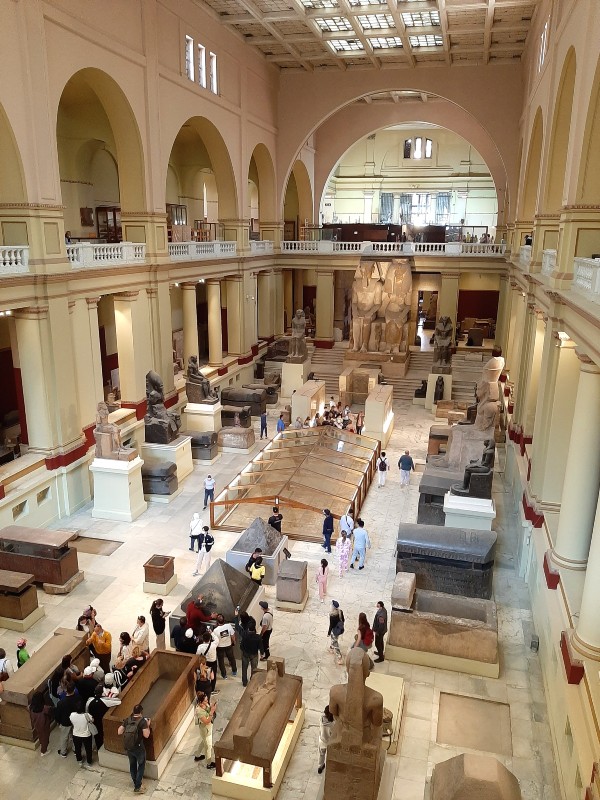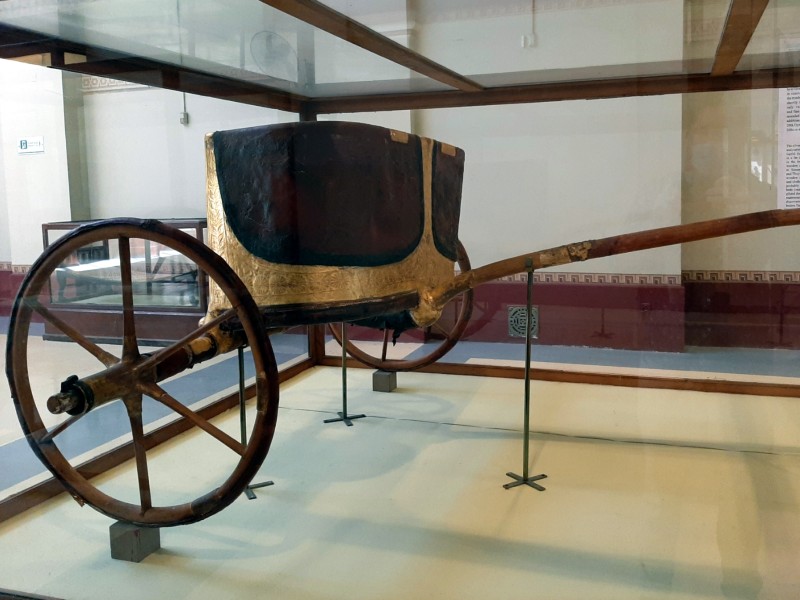Visiting the Museum of Egyptian Antiquities in Cairo
In this trip report, we will visit the Museum of Egyptian Antiquities – better known as the Egyptian Museum – in Cairo.
Cairo
There is a lot to see and do in Egypt’s capital and it’s a must to visit the Pyramids of Giza as well as the medieval old town of Cairo. However, your stay in Cairo is not complete without a visit to the famous Egyptian Museum!
From the excellent Sofitel Nile El Gezirah where I stayed, it was only a short walk to Tahrir Square in the heart of downtown Cairo on which the museum is located.
If you are staying elsewhere in the city, you can of course take a taxi or Uber or use public transport to reach the Egyptian Museum (Sadat metro station is just a stone throw away).





Entering the museum
You have to go through security twice in order to enter the Egyptian Museum, which is a bit of a hassle.
The first security parameter is outside the museum on the square itself.
If you are visiting the museum independently, you have to enter through a security checkpoint at the east side of the museum to gain access to the parking lot and the square in front of the museum entrance.
There, you have to go through security yet again before you reach the ticket offices, which are located in some small buildings in the garden opposite the main museum entrance.
A ticket to the Egyptian Museum currently costs 200 EGP (10.80 EUR), with discounted tickets available for Egyptians and Arabs and free tickets to all seniors over the age of 60.
Queues
The queues at the second security checkpoint and at the ticket offices looked absolutely massive.
Fortunately, not all people were actually queuing as many were just hanging around waiting for the other people from their tour groups to gather.
I later heard that mornings are actually peak times at the Egyptian Museum, as most organised tours visit the museum in the morning before going to the Giza Pyramids later in the day.
In fact, I even spoke to some Russians inside the museum who told me that they were on a Cairo day trip by bus from the Red Sea coast – a six hour overnight drive away!
Most visitors in the museum indeed seemed to be package tourists from Hurghada or Sharm El-Sheikh making the long trip to the capital for a quick visit to the Egyptian Museum and a look at the pyramids.
It’s not really something I would recommend doing if you want to savour all the magnificent sights of Cairo..

Inside the museum
Even though entering the Egyptian Museum might be a bit of a hassle, it’s all fantastic once you are inside.
The massive museum is stretched out over two floors and it’s so large that you can easily spend half a day here.
You will first enter the large atrium where some of the largest museum pieces are exhibited such as some large statues and sarcophagi.
Most notable are perhaps the colossal twin statues of Pharaoh Amenhotep III and his Great Royal Wife Tiye (of course, many Pharaohs had multiple wives!).



Yuya and Thuya
In my opinion, by far the most amazing sight in the museum are the coffins and mummies of Yuya and Thuya.
Although he wasn’t a Pharaoh, Yuya was a mighty figure in the 18th Dynasty. He served as adviser to Pharaoh Amenhotep III, who was married to Tiye, the daughter of Yuya and his wife Thuya.
The tomb of Yuya and Thuya (tomb KV46) was discovered in 1905 by James Quibell in the Valley of the Kings near Luxor.
The coffins and other objects found in the tomb were shipped off to the Egyptian Museum, where they can still be seen.
The mummies of Yuya and Thuya are amazingly preserved and are a true testimony to the embalming techniques used by the ancient Egyptians.
Yuya’s inner coffin is entirely covered with gold leaf and inlaid with precious stones and coloured glass.



Merneptah Stele
Another well-known object which is shown in the Egyptian Museum is the Merneptah Stele which was found in Thebes in 1896.
The text on the stele details Pharaoh Merneptah’s defeat of the Libyans in 1208 BC, but also tells the tale of another military campaign in Canaan.
Some hieroglyphs on the 27th line are translated by most scholars as ‘Israel’, which makes the Merneptah Stele the oldest textual reference of Israel.

Canopic shrine of Tutankhamun
When walking around the museum you cannot miss the huge canopic shrine of Pharaoh Tutankhamun.
This canopic shrine on a gilt wooden sledge contained the alabaster canopic box with Tuntankhamun’s mummified internal organs, which according to tradition where carefully removed during the embalming process.
The shrine is surrounded by four godesses, namely Isis, Nephthys, Selket and Neith. Their outstretched arms symbolise protection by the gods.
Also the golden throne of Tutankhamun can be admired in the Egyptian Museum.


Other exhibits
There are tons of other exhibits and artefacts to admire in the Egyptian Museum. You can literally find hundreds of mummy masks, statues and busts, weapons and everyday objects inside this museum.
The number of objects – there are some 120,000 items in the collection of the Egyptian Museum – is simply staggering.
All the important objects have information signs in both Arabic and English, although there are some parts of the museum where most of the objects are unlabelled.
Every period in the history of ancient Egypt is covered in the museum, from the Old Kingdom to the Middle Kingdom and finally the Ptolemaic Era during which Egypt was ruled by the Hellenistic dynasty of the Ptolemy’s.












Stuffy
Although I absolutely loved the Egyptian Museum and there is a lot to see, I have to say that at some points the Egyptian Museum felt a bit old-fashioned and stuffy.
There are some halls where the artefacts and objects were randomly put in glass vitrines without any labels whatsoever to explain what you are actually looking at.
For this reason, you may want to consider hiring a guide or buying a booklet which explains more about the background of the most important objects.





New museums
On 3th April 2021 – two months after my trip to Egypt – president Abdel Fattah El-Sisi opened the brand new National Museum of Egyptian Civilization (NMEC) in Fustat in the south of Cairo.
That day, some mummies which were previously showcased in the Egyptian Museum were transferred to their new home at the NMEC in a grand parade.
The NMEC is meant to complement the Egyptian Museum and should offer a more modern museum experience, highlighting all of Egypt’s history from prehistoric times to ancient Egypt and from Islamic history during the Middle Ages to modern-day times.
Later this year (2021), another museum is set to open in Giza a short distance away from the pyramids. Called the Grand Egyptian Museum (GEM), this museum will house the complete Tutankhamun collection, including his famous death mask.
Some other objects from the Egyptian Museum and museums and storages across the country will also be moved to the GEM.
If you might have visited one of these two museums, I’m very curious to hear about your experiences – especially how both the NMEC and GEM relate to the Egyptian Museum – so please leave a reply in the comment section below!
Back to the hotel
When you exit the Egyptian Museum you are forced to walk through a large museum shop and along some small souvenir stalls before you finally stand outside again in the gardens surrounding the building.
As I was walking across Tahrir Square back to my hotel on Zamalek Island I realised again how hot it was during the mid-afternoon in this sweltering city.
Fortunately, the swimming pool of my hotel and a cold beer made for a great combination to relax after the museum visit!




Conclusion
There is no doubt that the Egyptian Museum in Cairo is one of the world’s greatest museums. There are some absolutely amazing historical artefacts to admire in this large museum, which is a must to include on any Cairo and Egypt itinerary.
That said, some parts of the Egyptian Museum are a bit old-fashioned and stuffy and could do with some labelling or a makeover.
With the brand new National Museum of Egyptian Civilization (NMEC) in Fustat having already opened for visitors and the Grand Egyptian Museum (GEM) in Giza being set to be completed later this year, I’m curious how the old Egyptian Museum will hold up against these two newcomers in the greater Cairo area.
Yet even if those two new museums will blow away the Egyptian Museum on Tahrir Square, you cannot go wrong with having a look inside this granddaddy of all museums if you find yourself in downtown Cairo.
Trip report index
This article is part of the ‘Walk Like an Egyptian: A Grand Tour of Egypt‘ trip report, which consists of the following chapters:
1. Red-Eye Ramblings of a Late Night Flight to Cairo
2. A Visit to the Pyramids of Giza by Camel
3. Review: Sofitel Nile El Gezirah, Zamalek, Cairo
4. Exploring the Medieval Old Town and Islamic History of Cairo
5. Visiting the Museum of Egyptian Antiquities in Cairo (current chapter)
6. Mar Girgis: The Churches of Christian Old Cairo
7. Review: Ernst Watania Sleeping Train Cairo to Aswan
8. The Ancient Quarry of Aswan and the Unfinished Obelisk
9. A Boat Ride From Aswan to the Temple of Isis at Philae
10. A Visit to the Aswan High Dam and Lake Nasser
11. A Visit to the Nubian Village on Aswan’s Elephantine Island
12. Aswan Guide: A Visit to Egypt’s Most Stunningly Located City
13. A Half Day Trip From Aswan to Amazing Abu Simbel
14. Nile River Cruise Guide: All Info for Your Egypt Boat Trip
15. Review: M/S Princess Sarah Nile River Cruise Ship
16. Nile Cruise: Sailing From Aswan to Kom Ombo
17. A Visit to the Ancient Crocodile Temple of Kom Ombo
18. A Visit to the Temple of Horus at Edfu
19. Nile Cruise: Sailing From Edfu to Luxor
20. Luxor, Egypt: Visiting the Sights of Ancient Thebes
21. A Visit to Luxor’s Giant Temple Complex of Karnak
22. Visitor Guide to Wonderful Luxor Temple
23. Valley of the Kings: A Visit to Luxor’s Ancient Necropolis
24. The Temple of Hatshepsut: A Visit to a Unique Mortuary Temple
25. Review: Sofitel Winter Palace Hotel, Luxor, Egypt
26. Review: Daytime Train Luxor to Cairo, Egypt
27. Review: Steigenberger Hotel El Tahrir, Cairo
28. A Visit to the Pyramid of Djoser and the Saqqara Necropolis
29. A Visit to the Dahshur Pyramid Complex
30. Memphis: Exploring the Old Capital of Ancient Egypt
31. From Cairo to Alexandria by Train: My Travel Experience
32. Review: Paradise Inn Le Metropole Hotel, Alexandria, Egypt
33. Alexandria: A Visit to Egypt’s Historic Mediterranean Port City
34. Egypt: Impressions and Reflections After My Two Week Trip
35. Epilogue: Safety and How to Deal With Street Hassle in Egypt

